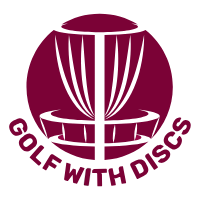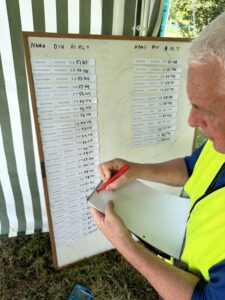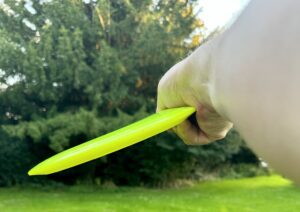Confused by disc golf numbers, ratings, or what half these numbers even mean? You’re not the only one squinting at a 9 | 5 | -2 | 1. This guide will explain disc golf numbers meaning, disc stability, and flight ratings in simple terms, helping you go from chucker to champion with the right disc selection. We’ll cover everything from speed, glide, turn, and fade ratings to understanding disc stability and behaviour in flight.
As a passionate disc golfer and long-time enthusiast of the sport, I’ve come to appreciate the intricate details that shape our disc selection process. In this comprehensive guide, we’ll embark on a journey to decode the enigmatic world of disc golf disc numbers and flight ratings. By understanding these fundamental concepts, you’ll gain valuable insights to level-up your game and understand the art of disc selection.
Disc Golf Numbers Chart and Meanings: What Are Disc Golf Disc Numbers?
How to Read Disc Golf Numbers: Demystifying the Code
When you first pick up a disc, those numbers (the disc golf numbers chart) might look puzzling. But understanding disc golf numbers, like speed, glide, turn, and fade, is key to knowing how a disc will perform. Here’s what each number in the chart means.
Speed: The first number in a disc golf disc’s ratings chart is its speed rating, ranging from 1 to 14. This speed rating reflects how fast the disc needs to be thrown to perform optimally. Higher speeds are ideal for experienced players aiming for longer distances. Beginners typically start with lower speed discs (e.g., 7-9) for better control and consistency.
Glide: Next up is the glide rating, denoted by a number between 1 and 7. This metric measures the disc’s ability to maintain lift and stay airborne. Higher glide ratings translate to discs that stay aloft longer, ideal for maximizing distance.
Turn: Moving on to the third number, we encounter the turn rating, represented on a scale from -5 to +1. A negative turn indicates the disc’s tendency to veer to the right (for right-handed backhand throws), while a positive turn implies a leftward flight path. Understanding turn is crucial for shaping shots and navigating tight fairways.
Fade: Last but not least, we have the fade rating, ranging from 0 to 5. Fade measures the disc’s stability at the end of its flight, with higher numbers indicating a stronger tendency to hook left (for right-handed backhand throws). Discs with minimal fade are prized for their straighter finishes and versatility in various shot scenarios.
How to Read Disc Golf Numbers and Flight Ratings
Navigating the Flight Path
Now that we’ve broken down the disc numbers, it’s time to look closer at flight ratings. Every disc comes with a set of flight characteristics that shape how it flies and how you should use it. Here’s the breakdown:
Stability: Stability plays a pivotal role in dictating a disc’s flight trajectory. Discs are typically categorized as overstable, stable, or understable based on their flight characteristics.
Overstable: These discs exhibit a tendency to resist turn and fade hard at the end of their flight. They’re ideal for windy conditions and precision fades around obstacles.
Stable: Stable discs fly straight with minimal turn and fade, making them reliable choices for a wide range of shots.
Understable: On the opposite end of the spectrum, understable discs turn more easily and offer enhanced distance potential with a gentle fade. They’re great for beginners learning to control their throws and for executing turnover shots.

Predicting Flight: Combining Speed, Glide, Turn, and Fade
By combining the disc’s speed, glide, turn, and fade ratings, you can anticipate its flight path with greater accuracy. Understanding how these factors interact allows you to choose the right disc for each shot and adapt to changing course conditions.
Understanding Disc Golf Numbers and What They Mean for Stability
Most new players ask what disc golf numbers mean in plain English. It’s not just speed, glide, turn, and fade—it’s how those ratings combine to define a disc’s stability. If a disc has high turn and low fade, it’s probably understable. If the numbers are reversed, you’re looking at an overstable workhorse.
Disc Stability Ratings: Overstable vs. Understable Discs
Disc stability ratings help you understand a disc’s flight behaviour. Discs fall into three categories: overstable, stable, and understable. Overstable discs tend to resist turn and offer a strong fade, ideal for windy conditions or precise, controlled throws. In contrast, understable discs have a higher turn, making them great for newer players and distance throws. Knowing if a disc is overstable vs. understable can help you make the best choice for your throwing style.
Disc Selection Tips: Choosing the Right Disc Golf Disc for Your Throw
Personalized Recommendations
With countless options on the market, selecting the right disc for your throw can feel like a challenge. Our disc selection tips will help you narrow down discs that align with your skill level, throwing style, and game goals.
- Know Your Skill Level: Consider your skill level and throwing style when choosing a disc. Beginners may benefit from discs with lower speed and stability ratings, while advanced players can explore a wider range of options to suit their preferences.
- Experiment and Learn: Don’t be afraid to experiment with different discs and observe how they perform in various situations. This hands-on approach will help you gain a deeper understanding of disc flight dynamics and refine your disc selection process over time.
- Seek Expert Advice: Don’t hesitate to seek advice from experienced players or disc golf professionals. They can offer valuable insights and recommendations based on their own experiences and expertise.
- Stay Informed: Keep abreast of new disc releases and updates in the disc golf community. Staying informed about the latest innovations and trends will enable you to make informed decisions and stay ahead of the curve.
Distance vs. Control in Disc Selection: Finding Your Balance
When selecting a disc, it’s important to consider distance vs. control. Discs with higher speed ratings offer distance but can be harder to control, while lower-speed discs offer more precision. Beginners often benefit from beginner-friendly discs with lower speeds, prioritising control as they learn to manage flight path and accuracy.
Disc Golf Terminology and FAQs: Addressing Common Queries
The purpose of the disc golf flight rating system is to standardize disc golf terminology and offer players a way to evaluate the flight characteristics of different discs. Understanding this system—including speed, glide, turn, and fade ratings—helps players choose the right disc for their throw.
The numbers on a disc golf disc represent its speed, glide, turn, and fade ratings, respectively. These numbers provide valuable insights into the disc’s flight characteristics and help players choose the right disc for each shot.
Flight ratings are important in disc golf because they help players understand how a disc will fly. This knowledge allows them to choose the right disc for each shot and adapt to different course conditions
Consider factors such as your skill level, throwing technique, and course conditions when selecting a disc. Beginners may prefer slower, more understable discs, while experienced players can experiment with a wider range of options to suit their preferences.
Not necessarily. Higher flight ratings indicate specific flight characteristics, but the best disc for a player depends on their skill level, throwing style, and course conditions.
Disc golf flight ratings affect your game by influencing the flight path and behavior of the disc. Understanding these ratings enables you to make informed disc selections and execute shots with greater precision.
They represent the disc’s speed, glide, turn, and fade ratings. The combination affects stability and flight path.
Understanding the Art of Disc Selection
You now know what disc golf numbers mean—and more importantly, how to use them to make better disc choices. The numbers aren’t just printed noise; they’re a shortcut to better throws, smarter decisions, and fewer wasted shots.
Struggling to find that perfect disc with the right speed, glide, turn, and fade ratings? The Disc Matchmaker tool can help you find similar golf discs to replace a favourite or add new options to your bag. Just enter a disc name and brand, and the Matchmaker will suggest options with similar stability and performance characteristics. It’s an easy way to personalise your disc selection and match discs to your throwing style. Try it out and let the Disc Matchmaker help you find your next go-to disc!






